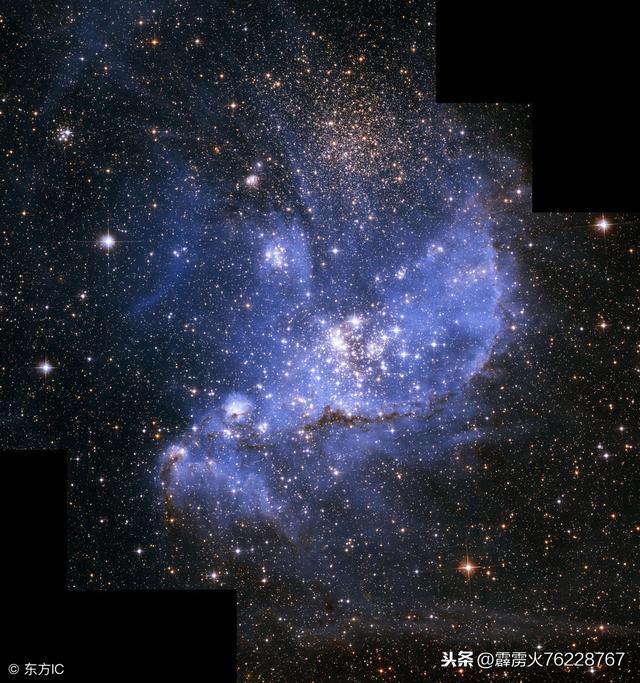译文:
内容
1 历史
1.1 广义相对论
1.2 黄金时代
1.3 词源
2 属性和结构
2.1 物理性质
2.2 事件视界
2.3 奇点
2.4 光子球
2.5 能层
2.6 最内部稳定圆轨道(ISCO)
3 形成和演变
3.1 引力坍缩
3.1.1 原始黑洞和大爆炸
3.2 高能碰撞
3.3 增长
3.4 蒸发
4 观察证据
4.1 检测合并黑洞的引力波
4.2 恒星围绕射手座A *的运动
4.3 物质的增加
1、历史
译文:
1784年11月天文学先驱、英国牧师约翰·米歇尔在发表的一封信中简要地提出一个甚至光线都无法逃脱的巨大的星体的想法。米歇尔通过简单的计算,假定这种星体可能具有与太阳相同的密度,并且得出的结论:当恒星的直径超过太阳的500倍时会形成这样的物体,其表面逃逸速度超过通常的光速。米歇尔正确地指出,这种超大质量但并不辐射的星体可以通过它们对附近可见物体的引力效应而被发现。[12] [7] [13]当时的学者起初对这样的提议--巨大但看不见的恒星可能隐藏在平面视野中感到兴奋,但是在19世纪早期,当光的波浪性变得明显时,这种热情减退了。[14]如果光是波而不是“粒子”,那么重力会对逃逸的光波产生什么影响就变得不清楚了。[7] [13]现代相对论导致对米歇尔的想法产生质疑。米歇尔的观点是:直接从超大质量星体的表面发射的光线,被星体的引力减速,甚至停止,然后自由落回到星体表面。[15]
(注:起初星体使用的是body这个词,这是拟人化的表达,米歇尔同时也是牧师。待相对论之后,星体用star表达,有将star翻译为恒星的,不确切。
西方近代文化底蕴中存在三种主要文化:宗教文化、唯心文化、数理文化,因此西方的近代天文学、物理学表达中,一旦涉及比喻式的表达,有时候会具有宗教文化色彩。这一点还需注意。就像爱因斯坦的疑问:上帝是否掷色子?意译为中国话就是:老天爷(大自然)有没有随机性?这一点,中国古人想了很多,也表达了很多看法。老子在《道德经》中的表达最尖锐。
在狭义和广义相对论发表以后,当时除了水星进动现象的计算比牛顿的方法更精确以外,这有观测证据,其他理论预言,并未及时得到证实。光线在大引力的作用下发生弯曲的这个“简单”证实,也是在广义相对论发表十年之后通过一次日食才得到证实。更多的理论预言证实,都是几十年后哈勃望远镜上天以后的事情了。由于相对论当时尚未有众多的证实证据,爱因斯坦获得诺贝尔奖是因为光的波、粒两重性理论。
光的波粒两重性的提法,同时也解开了文中提到的困惑--“如果光是波而不是“粒子”,那么重力会对逃逸的光波产生什么影响就变得不清楚了。”
相对论发表以后,当时的科学家的看法是全世界能够看懂的没几个人。这种情况,接近百年后,依然并未有多大改变。也许是当初的几个人变成几万人或几十万人,相对于地球的总人口,这个数量变化,并未产生本质性的理论影响。但是,却产生了深远的文化影响。毕竟这是仰望天空的思考,而仰望星空这是古典的哲学的一个重大主题。
至今对相对论的混乱解释依然比比皆是。真对这些东西感兴趣,还是看看原文,理解一下原文最好。这种内容,有十年八年的努力学习,多少会理解一些。)

原文:
The idea of a body so massive that even light could not escape was briefly proposed by astronomical pioneer and English clergyman John Michell in a letter published in November 1784. Michell's simplistic calculations assumed that such a body might have the same density as the Sun, and concluded that such a body would form when a star's diameter exceeds the Sun's by a factor of 500, and the surface escape velocity exceeds the usual speed of light. Michell correctly noted that such supermassive but non-radiating bodies might be detectable through their gravitational effects on nearby visible bodies.[12][7][13] Scholars of the time were initially excited by the proposal that giant but invisible stars might be hiding in plain view, but enthusiasm dampened when the wavelike nature of light became apparent in the early nineteenth century.[14] If light were a wave rather than a "corpuscle", it became unclear what, if any, influence gravity would have on escaping light waves.[7][13] Modern relativity discredits Michell's notion of a light ray shooting directly from the surface of a supermassive star, being slowed down by the star's gravity, stopping, and then free-falling back to the star's surface.[15]
译文:
1.1广义相对论
1915年,阿尔伯特爱因斯坦发展了他的广义相对论,引力影响光的运动已经得到验证。仅仅几个月后,卡尔·施瓦茨柴尔德找到了爱因斯坦场方程的解决方案,该方程描述了点质量和球形质量的引力场。[16]在施瓦茨柴尔德提出这个解决方案之后的几个月,亨德里克·洛伦茨的学生约翰尼斯·卓斯特独立地为点质量提供了相同的解决方案,并对其属性进行了更广泛的描述。[17] [18]这个解决方案在现在被称为施瓦茨柴尔德半径的地方有一种特殊的行为,它变得奇异,这意味着爱因斯坦方程中的某些项变得无限。在当时,并没有完全理解这个表象的性质。 1924年,亚瑟·爱丁顿表明奇点在坐标变化后消失了(参见爱丁顿-芬克尔斯坦坐标)。尽管直到1933年,乔治斯莱马雷才意识到这意味着施瓦茨柴尔德半径的奇点是非物理坐标奇点, [19]但亚瑟·爱丁顿在1926年的一本书中评论了一颗质量被压缩到施瓦兹希尔半径的恒星的可能性,并指出爱因斯坦的理论允许我们排除像参宿四这样的可见恒星拥有过大的密度,原因在于“一颗2.5亿公里半径的恒星不太可能像太阳一样具有如此高的密度。首先,万有引力会使光无法从其逃脱,光线像石头一样落回到地球上。其次,红移光谱线将会太大以至于频谱将不再存在。第三,质量将产生如此大的时空度量曲率,空间将围绕星体关闭,把我们屏蔽在外面(即,不知所踪) 。“[20] [21]
1931年,Subrahmanyan Chandrasekhar(施瓦兹希尔)利用狭义相对论计算出一个非旋转的、超过一定的极限质量的坍塌没有稳定的解(现在称为施瓦兹希尔极限,为1.4M☉)。[22]他的论点遭到了许多同时代人的反对,比如Eddington和Lev Landau,他们认为一些尚未知的机制会阻止崩溃。[23]他们是部分正确的:比施瓦兹希尔极限略大的白矮星会坍缩成中子星[24],它本身是稳定的。但在1939年,罗伯特·奥本海默和其他人预测,基于施瓦兹希尔提出的理由,中子星超过另一个极限(托尔曼 - 奥本海默 - 沃尔科夫极限)将进一步崩溃,并得出结论,没有物理定律可能干预并阻止这样一些星体坍塌成为黑洞。[25]根据泡利不相容原理,他们的原始计算结果为0.7M☉;随后考虑强力介导的中子 - 中子排斥将估计值提高到约1.5M☉至3.0M☉。[26]基于对中子星合并的GW170817的观测,它被认为不久之后会产生一个黑洞,将TOV极限估计值提高到了〜2.17M☉。[27] [28] [29] [30] [31]
奥本海默和他的合作者解释了施瓦兹希尔半径边界处的奇点,表明这是时间停止的泡沫的边界。 对于外部观察者来说,这是一个有效的点,但对于内部观察者不是这样的。 由于这种特性,坍塌的恒星被称为“冻结恒星”,因为外部观察者会看到恒星表面在其坍塌进入施瓦兹希尔半径的那一刻及时冻结。[32]
(注:翻译这段很吃力,未接触过这方面的观测证据以及计算的过程,大谈相对论的网文,不见得一定真懂相对论。以讹传讹,也是这么来的。)
原文:
General relativity
In 1915, Albert Einstein developed his theory of general relativity, having earlier shown that gravity does influence light's motion. Only a few months later, Karl Schwarzschild found a solution to the Einstein field equations, which describes the gravitational field of a point mass and a spherical mass.[16] A few months after Schwarzschild, Johannes Droste, a student of Hendrik Lorentz, independently gave the same solution for the point mass and wrote more extensively about its properties.[17][18] This solution had a peculiar behaviour at what is now called the Schwarzschild radius, where it became singular, meaning that some of the terms in the Einstein equations became infinite. The nature of this surface was not quite understood at the time. In 1924, Arthur Eddington showed that the singularity disappeared after a change of coordinates (see Eddington–Finkelstein coordinates), although it took until 1933 for Georges Lemaître to realize that this meant the singularity at the Schwarzschild radius was a non-physical coordinate singularity.[19] Arthur Eddington did however comment on the possibility of a star with mass compressed to the Schwarzschild radius in a 1926 book, noting that Einstein's theory allows us to rule out overly large densities for visible stars like Betelgeuse because "a star of 250 million km radius could not possibly have so high a density as the sun. Firstly, the force of gravitation would be so great that light would be unable to escape from it, the rays falling back to the star like a stone to the earth. Secondly, the red shift of the spectral lines would be so great that the spectrum would be shifted out of existence. Thirdly, the mass would produce so much curvature of the space-time metric that space would close up around the star, leaving us outside (i.e., nowhere)."[20][21]
In 1931, Subrahmanyan Chandrasekhar calculated, using special relativity, that a non-rotating body of electron-degenerate matter above a certain limiting mass (now called the Chandrasekhar limit at 1.4 M☉) has no stable solutions.[22] His arguments were opposed by many of his contemporaries like Eddington and Lev Landau, who argued that some yet unknown mechanism would stop the collapse.[23] They were partly correct: a white dwarf slightly more massive than the Chandrasekhar limit will collapse into a neutron star,[24] which is itself stable. But in 1939, Robert Oppenheimer and others predicted that neutron stars above another limit (the Tolman–Oppenheimer–Volkoff limit) would collapse further for the reasons presented by Chandrasekhar, and concluded that no law of physics was likely to intervene and stop at least some stars from collapsing to black holes.[25] Their original calculations, based on the Pauli exclusion principle, gave it as 0.7 M☉; subsequent consideration of strong force-mediated neutron-neutron repulsion raised the estimate to approximately 1.5 M☉ to 3.0 M☉.[26] Observations of the neutron star merger GW170817, which is thought to have generated a black hole shortly afterward, have refined the TOV limit estimate to ~2.17 M☉.[27][28][29][30][31]
Oppenheimer and his co-authors interpreted the singularity at the boundary of the Schwarzschild radius as indicating that this was the boundary of a bubble in which time stopped. This is a valid point of view for external observers, but not for infalling observers. Because of this property, the collapsed stars were called "frozen stars", because an outside observer would see the surface of the star frozen in time at the instant where its collapse takes it to the Schwarzschild radius.[32]
待续。。。。。。
,






